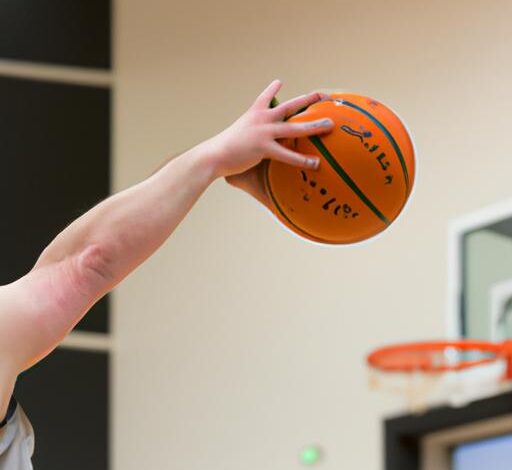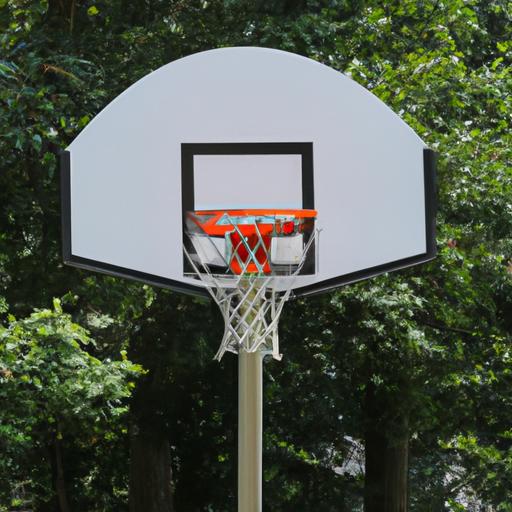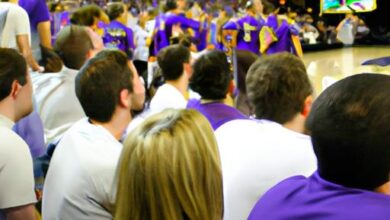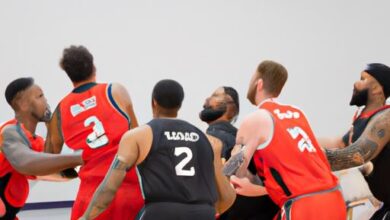What is Reaching in Basketball?

Basketball, the exhilarating sport that combines athleticism, coordination, and teamwork, has captured the hearts of millions worldwide. Whether you’re a passionate player or an avid fan, understanding the intricacies of the game is vital to fully appreciate its beauty. One such fundamental aspect of basketball is “reaching.” But what exactly does reaching mean in the context of basketball?
In basketball, reaching refers to a defensive technique where a player extends their arm(s) towards an opponent in an attempt to disrupt their dribble or shot. While it may seem like a defensive strategy to impede the offensive player’s progress, reaching is subject to specific rules and regulations to maintain fair play.
Reaching is governed by a rule that aims to prevent excessive physical contact between players and ensure a fair and safe playing environment. This rule prohibits defenders from making excessive, unnecessary, or aggressive contact with an opposing player while reaching for the ball. The primary objective of this rule is to promote fair competition and prevent potential injuries.
Understanding the rule of reaching is crucial for both players and fans alike. By familiarizing yourself with the concept, you not only enhance your knowledge of the game but also gain a deeper appreciation for the skills required to execute effective defensive strategies.
Now that we have a basic understanding of reaching in basketball, let’s delve deeper into the specifics of this rule and its implications in Section 2.
Understanding the Rule of Reaching in Basketball
Reaching as a Defensive Technique
Reaching is a defensive technique commonly employed by basketball players to disrupt the offensive player’s rhythm and potentially steal the ball. It involves extending one’s arm(s) towards the opponent in an attempt to deflect the ball or force a turnover. While reaching can be effective when executed correctly, it is important to understand the limitations and regulations surrounding this defensive move.
Definition of the Rule and Its Purpose
The rule of reaching in basketball is designed to maintain a fair and balanced playing field. According to the rulebook, defenders must avoid excessive, unnecessary, or aggressive contact when reaching for the ball. This means that while it is permissible to reach for the ball, players must do so without impeding the offensive player’s progress or resorting to physical force.
The purpose of this rule is twofold: to protect the integrity of the game and to ensure the safety of all players involved. Reaching fouls can lead to injuries, disrupt the flow of the game, and create an unfair advantage for the defensive team. By enforcing the rule, basketball authorities aim to foster an environment where players can showcase their skills without compromising their safety.
Importance of Knowing and Following the Rule
Understanding and adhering to the rule of reaching is crucial for players at all levels of the game. By familiarizing themselves with the specifics of the rule, players can avoid committing unnecessary fouls and maintain good sportsmanship. Additionally, knowing the boundaries of reaching allows defenders to develop alternative defensive strategies that are effective without resorting to risky or illegal maneuvers.
Now that we have a grasp of the rule of reaching in basketball, let’s move on to Section 3, where we explore how to identify reaching fouls in the game.
Identifying Reaching Fouls in Basketball
Examples of actions that constitute reaching fouls
Reaching fouls can occur when a defender engages in certain actions that violate the rules of reaching in basketball. Let’s explore some common examples to help you identify reaching fouls:
-
Swiping at the ball recklessly: When a defender wildly swings their arm(s) at the ball with little control or regard for the offensive player’s safety, it can result in a reaching foul. This reckless swiping is often seen when players attempt to steal the ball without proper technique or timing.
-
Grabbing or holding the opponent: If a defender grabs onto their opponent’s arm, jersey, or any part of their body while reaching for the ball, it constitutes a reaching foul. Such actions hinder the offensive player’s freedom of movement and are considered illegal in basketball.
Common mistakes made by players when reaching
While reaching may seem like a natural defensive instinct, it is essential to avoid common mistakes that can lead to reaching fouls:
-
Overreaching: Players often extend their arms beyond their natural reach, hoping to disrupt the offensive player’s dribble or shot. However, this overextension can make them more susceptible to committing reaching fouls. It is crucial to maintain control and stay within your defensive range.
-
Lunging forward: In an attempt to reach the ball, players sometimes lunge forward with their upper body, losing their balance and stability. This forward momentum not only compromises their defensive position but also increases the likelihood of committing reaching fouls.
Consequences of committing reaching fouls
Reaching fouls carry consequences that can impact both the individual player and the team as a whole:
-
Personal fouls: Reaching fouls result in personal fouls being assessed against the player who committed the infraction. Accumulating personal fouls can lead to disqualification from the game, limiting the player’s playing time and negatively affecting their team’s defensive capabilities.
-
Free throw opportunities: When a team commits reaching fouls, the opposing team is awarded free throws. These free throws provide the offensive team with an opportunity to score uncontested points, shifting the momentum of the game in their favor.
Now that we have a clear understanding of the actions that constitute reaching fouls, the common mistakes to avoid, and the consequences of committing such fouls, let’s move on to Section 4, where we explore the impact of reaching on the game.
Impact of Reaching on the Game
Reaching, when executed correctly, can be a powerful defensive technique. However, it also has a significant impact on the flow of the game and can influence the outcome of plays. Let’s explore the various aspects of reaching and its implications on the game of basketball.
How reaching affects the flow of the game
Reaching can disrupt the offensive player’s rhythm, forcing them to adjust their dribble or shot. This defensive strategy can create turnovers, leading to fast-break opportunities for the defending team. Conversely, improper reaching can result in fouls, granting the opposing team free throws or additional possessions. The flow of the game can be greatly influenced by the success or failure of reaching attempts.
Defensive advantages and disadvantages of reaching
One advantage of reaching is the potential to steal the ball, providing an immediate defensive advantage. By successfully reaching and dislodging the ball from the offensive player’s hands, defenders can regain possession and transition into offense. However, reaching also carries risks. If a defender mistimes their reach or makes excessive contact, they may commit a foul, granting the offensive team an advantage. Balancing the advantages and disadvantages of reaching is essential for effective defensive play.
Strategies to avoid reaching while maintaining effective defense
To avoid unnecessary reaching fouls, defenders should focus on positioning and footwork. By maintaining a low defensive stance and moving laterally, defenders can impede the offensive player’s progress without resorting to reaching. Body positioning and anticipation skills are also crucial. By correctly reading the offensive player’s movements and positioning themselves accordingly, defenders can intercept passes or contest shots without relying solely on reaching.
By employing these strategies, defenders can maintain effective defense without resorting to excessive reaching. This not only reduces the risk of fouls but also allows for more controlled defensive play, disrupting the offense while minimizing potential disadvantages.
In the next section, we will explore practical tips to improve defensive skills without resorting to reaching. Stay tuned for Section 5!
Tips to Improve Defensive Skills without Reaching
As a basketball player, refining your defensive skills is essential to becoming a well-rounded player. While reaching may seem like a tempting option, there are alternative strategies that can be just as effective, if not more, without running the risk of committing fouls. Here are some valuable tips to enhance your defensive skills without relying on reaching:
1. Proper Defensive Stance and Footwork
Maintaining a solid defensive stance is the foundation of effective defense. Start by bending your knees, keeping your feet shoulder-width apart, and maintaining a low center of gravity. This allows you to swiftly move laterally and react to offensive maneuvers. Additionally, focus on staying on the balls of your feet for quicker movement and better balance.
Footwork is another crucial aspect of defense. Mastering techniques like the “slide step” and “cross step” enables you to stay in front of your opponent without reaching. Practice these footwork drills to enhance your agility and defensive capabilities.
2. Utilizing Body Positioning to Impede the Offensive Player
Instead of reaching, focus on using your body to impede the offensive player’s progress. Position yourself between your opponent and the basket, forcing them to take a more challenging route. This technique, often referred to as “cutting off the driving lane,” allows you to maintain defensive integrity without resorting to reaching. By using your body effectively, you can disrupt their rhythm and limit their scoring opportunities.
3. Developing Anticipation and Reaction Skills
Anticipating your opponent’s moves and reacting promptly is a valuable skill that can significantly enhance your defensive prowess. Study your opponent’s tendencies, learn their preferred moves, and develop a sense of anticipation. By honing your reaction skills, you can be proactive in defending without the need to reach.
By implementing these tips into your defensive strategy, you can become a formidable force on the court while avoiding unnecessary fouls. Remember, mastering the art of defense is not about resorting to aggressive tactics like reaching but rather about honing your skills, positioning, and instincts to outwit your opponents.
In the next section, we will explore the impact of reaching on the flow of the game and the advantages and disadvantages it presents.
Conclusion: So above is the What is Reaching in Basketball? article. Hopefully with this article you can help you in life, always follow and read our good articles on the website: sports.canadianpharmaciesgen.com



